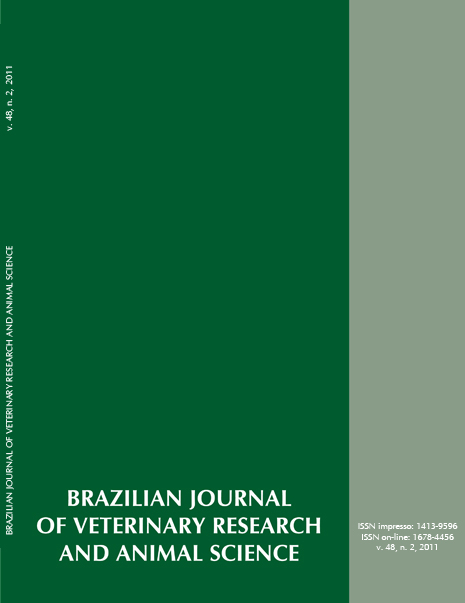Evaluation of bronchoalveolar fluid of horses with inflammatory airway disease
DOI:
https://doi.org/10.11606/S1413-95962011000200004Keywords:
Equine, Inflammatory airway disease, Cytology, Bronchoalveolar lavageAbstract
The aim of this study was to characterize the cytology profile of bronchoalveolar lavage from police horses with asymptomatic Inflammatory Airway Disease (IAD). Seventeen adult horses, males and females, with ages ranging from 11 to 24 years old were utilized. The control group (eight horses) presented vital signs within the physiologic range, normal pulmonary percussion and auscultation, no abnormalities at respiratory endoscopy and at the measurement of the maximal intra-pleural pressure difference. The cell count of bronchoalveolar lavage (BAL) should be up to 4%, 0.7%, 3.3% to neutrophil, eosinophil and epithelial cell, and ranging of 17.0 to 56.7%, 29 to 75.7%, 0.7 to 13.7% to lymphocytes, macrophages and mast cell, respectively. The diseased group (nine animals) presented findings compatible with lower airway disease, at least during endoscopy and showed a neutrophil counts above 5% and below 25%. Asymptomatic IAD was characterized by neutrophilic infiltrate, discrete reduction in macrophage count with increased number of foamy macrophages and discrete eosinophilic infiltrate and marked increase in the number of epithelial cells. Due to the asymptomatic character of IAD in police horses, BAL is the preferred diagnostic and follow-up method since it allows recognition of the disease, evaluation of treatment and helps the implementation of a graded and rational work regime that aims at improving welfare of those animals as well as extending their usage as patrolling horses.Downloads
Download data is not yet available.
Downloads
Published
2011-04-01
Issue
Section
UNDEFINIED
License
The journal content is authorized under the Creative Commons BY-NC-SA license (summary of the license: https://
How to Cite
1.
Lessa DAB, Jorge MLL de A, Viana EB, Alencar NX de, Fernandes WR. Evaluation of bronchoalveolar fluid of horses with inflammatory airway disease. Braz. J. Vet. Res. Anim. Sci. [Internet]. 2011 Apr. 1 [cited 2024 Apr. 17];48(2):123-30. Available from: https://www.revistas.usp.br/bjvras/article/view/34363





